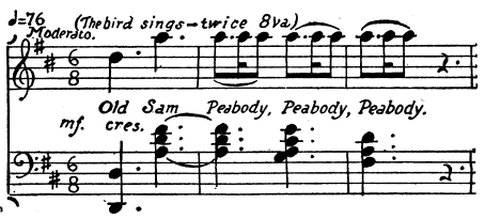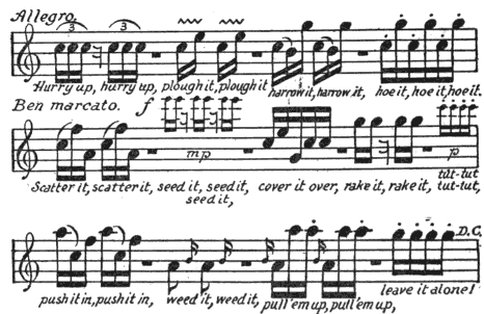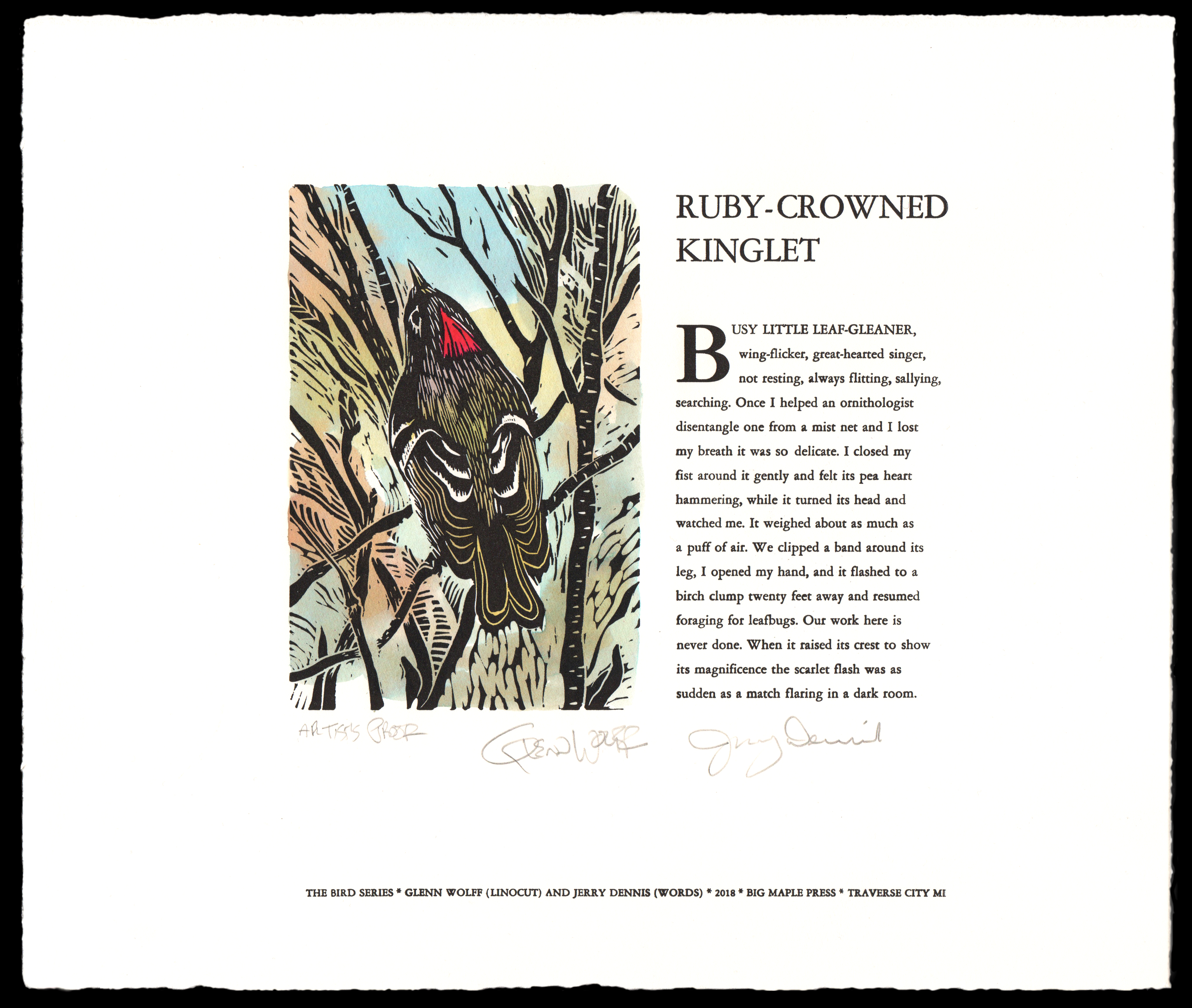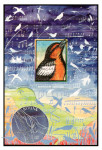If you’re like me, not even the recent spell of cold and snow can push away the stirrings of spring fever. My symptoms always include greater than usual obsessions with birds and fish and morel mushrooms. Today it’s mostly birds.
With that in mind, maybe it’s a good time to revisit a couple of my early blog posts about bird songs and our efforts to render them phonetically and as musical scores:
I WAS AWAKENED EARLY THIS MORNING by a northern cardinal and a tufted titmouse singing in the walnut tree outside my window. And I could hear also, in a kind of counterpoint to those bright and piercing notes, the tap-tap-tap of dripping eaves. Is it possible? Are rumors of spring true?
Birdsong has probably inspired more poetry and music than any event in nature. How we interpret those songs makes up a tiny but vigorous sub-genre of literature that can sometimes be as entertaining as the songs themselves. [Songs of the northern cardinal can be heard here] [Listen to a tufted titmouse here]
Thoreau’s journals are filled with examples. He writes that the wood thrush’s “cool bars of melody” make him think of “…the liquid coolness of things that are just drawn from the bottom of springs.”
For John James Audubon, the same bird’s song recalls “… the emotions of the lover, who at one moment exults in the hope of possessing the object of his affections, and the next pauses in suspense…” [To hear the song of a wood thrush, go here]
The hermit thrush, says John Burroughs, “…suggests a serene religious beatitude as no other sound in nature… ‘O spheral, spheral!’… ‘O holy, holy! O clear away, clear away! O clear up, clear up!’ interspersed with the finest trills and the most delicate preludes. It … seems to be the voice of that calm, sweet solemnity one attains in his best moments.”
Another thrush (what kind he doesn’t say) inspired Lewis Thomas to write: “The thrush in my backyard sings down his nose in meditative liquid runs of melody, over and over again, and I have the strongest impression that he does this for his own pleasure. Some of the time he seems to be practicing, like a virtuoso in his apartment. He starts a run, reaches a midpoint in the second bar where there should be a set of complex harmonics, stops, and goes back to begin over, dissatisfied… It is a meditative, questioning kind of music, and I cannot believe that he is simply saying, ‘thrush here.’” [Listen to a hermit thrush here]
Here is John Muir on the song of the American dipper (he called it the Water Ouzel): “…his mellow, fluty voice is ever tuned to downright gladness…his music is that of the streams refined and spiritualized. The deep booming notes of the falls are in it, the trills of rapids, the gurgling of margin eddies, the low whispering of level reaches, and the sweet tinkle of separate drops oozing from the ends of mosses and falling into tranquil pools.”
And Theodora Stanwell-Fletcher on the same bird:“…a burst of rippling notes… a clear, sweet song… In vivid moonlight we could see them… dipping and bobbing on rocks in the cold shining water – and singing. Their song echoed back and forth so that all the lake was ringing with it. When we went inside again the birds flew above our roof and poured their music down on us… those crystal tinkles, which matched so perfectly the icy purity of the winter night.” [For the song of the American dipper, go here]
Roger Tory Peterson on the song of another Western species, the canyon wren: “A gushing cadence of clear, curved notes tripping down a scale…” [Songs of the canyon wren can be heard here]
Donald Culross Peattie on the song of the white-throated sparrow: “…the white-throat’s touching chromatic pierces the heart; it blends sadness and happiness… a song like a cry, a song that speaks of the antiquity of time, the briefness of life.”
[To hear the "Old Sam Peabody, Peabody" call of the white-throated sparrow, go here]
Izaac Walton, on the nightingale: “…which breathes such sweet loud music out of her little instrumental throat that it might make mankind to think miracles are not ceased. He that at midnight…should hear, as I have very often, the clear airs, the sweet descants, the natural rising and falling, the doubling and redoubling of her voice, might well be lifted above earth and say, ‘Lord, what music hast Thou provided for the saints in heaven, when Thou affordest bad men such music on earth.’”
D.H. Lawrence, also on the nightingale: “A kind of brilliant calling and interweaving of glittering exclamation such as must have been heard on the first day of creation, when the angels suddenly found themselves created, and shouting aloud before they knew it. Then there must have been a to-do of angels in the thickets of heaven: ‘Hello! Hello! Behold! Behold! Behold! It is I! It is I! What a mar-mar-marvelous occurrence! What!”
Thoreau again, on the exquisite song of the tiny winter wren: “It was surprising for its steady and uninterrupted flow… It reminded me of a fine corkscrew stream issuing with incessant lisping tinkle from a cork, flowing rapidly.” [The winter wren's song is here]
My friend Mary Ann Linsell tells me she has always enjoyed the song of the white-throated sparrow, so famously interpreted as “Old Sam Peabody, Peabody, Peabody.” It brings to mind the early 20th century ornithologist and musician F. Schuyler Mathews, who considered phonetic transcriptions of bird song an insult to the birds. He pointed out that the song of the “Peabody-bird” could just as easily be articulated as “Sow wheat Pe-ver-ly, Pe-ver-ly, Pe-ver-ley,” or “All day whit-tl-in’, whit-tl-in’, whit-tl-in’.” The same was true, he said, for every phonetic interpretation of every
bird’s song. To correct that imprecision he labored for twenty years to transpose the songs of 127 species into dots on staves, and published them in one of the earliest identification guides to birdsong, Field Book of Wild Birds and Their Music, A Description of the Character and Music of Birds, Intended to Assist in the Identification of Species Common in the United States East of the Rocky Mountains (1904; expanded and reprinted in 1921).
 The song of the white-throated sparrow as transcribed by Mathews
The song of the white-throated sparrow as transcribed by Mathews[The Cornell Lab of Ornithology's recording of a white-throated sparrow is here]
Although Mathews’s scores can be played on a piano, he insisted that to perform them accurately they must be whistled. It would take a whistling prodigy, however, to do justice to some of those songs. They include dazzlingly complex chords made by birds equipped with twin vocal mechanisms that make it possible for them to sing two notes simultaneously. Also represented are songs composed of cascades of notes—virtual waterfalls of notes—as dense as 64 to the bar. And there are songs to be whistled that we will probably never hear, such as the “strident and insectlike” song of the grasshopper sparrow, which Mathews admits is pitched “so high that 9 out of 10 people can’t hear it singing 30 feet away.”
More recently, ornithologists have counted the music output of certain songbirds and come up with astonishing figures. A red-eyed vireo was once observed singing a two- to four-note song a total of 22,197 times in a 14-hour period. The marsh warbler of Europe, Africa, and Asia spends two months of the year in its breeding grounds from the British Isles to the Ural Mountains of Siberia, then migrates to tropical Africa—a round trip of as much as 4,800 miles. During those long migrations it hears a great variety of songs from other birds, which it faithfully incorporates into a repertoire it puts to work during three to four days of virtually non-stop singing in the spring. A Belgian scientist who spent ten years studying the warbler’s song found that it mimicked as many as 210 other species during each 30-minute burst of song.
A musical prodigy closer to home, and a particular favorite of Gail’s and mine, is the brown thrasher, which should show up any day here in northern Michigan. This large, thrushlike bird has the greatest repertoire of any North American songbird and has been credited with as many as 3,000 melodies. For its performances it likes to take up a position at the top of an aspen, birch, or crab apple in partially open terrain where it can be seen and heard to full advantage. Once you hear its performance you’re not likely to forget it. It strings together jazzlike riffs mimicked from other birds and some of its own invention, and delivers them with ceaseless energy. Mathews noted that the song offers these words of advice to farmers: “Shuck it, shuck it; sow it, sow it; Plough it, plough it; hoe it, hoe it.” Thoreau reported in Walden that the brown thrasher’s “rigmarole, his amateur Paganini performances,” kept farmers company as they planted corn with the constant reminder: “Drop it, drop it, —cover it up, cover it up,—pull it up, pull it up, pull it up.”
 The song of the brown thrasher, as transcribed by Mathews
The song of the brown thrasher, as transcribed by Mathews[The Cornell Lab of Ornithology's recording of a brown thrasher is here]
Birds on Wires
While on the subject of birds and musical notation, here’s something strange and wonderful that a friend found on YouTube and sent along. I guarantee it will lift you up:
https://www.youtube.com/watch?v=LoM4ZZJ2UrMhttp://
___________________________________
…And Something New from Jerry Dennis and Glenn Wolff:

The new broadside from Jerry and Glenn—the first in their Bird Series. Learn more at www.bigmaplepress.com


Leave a Comment